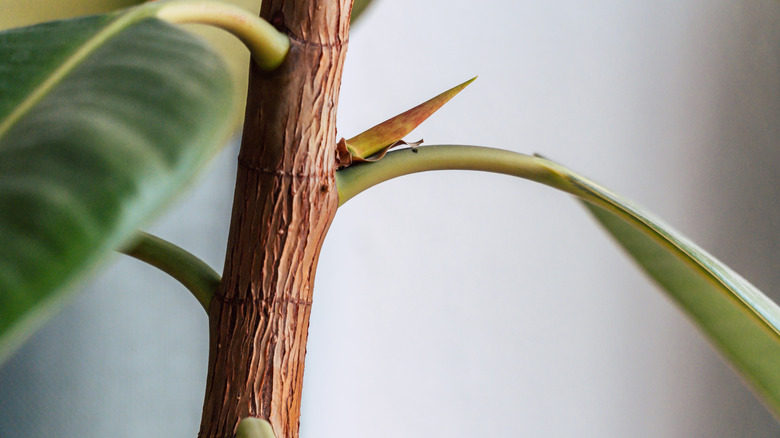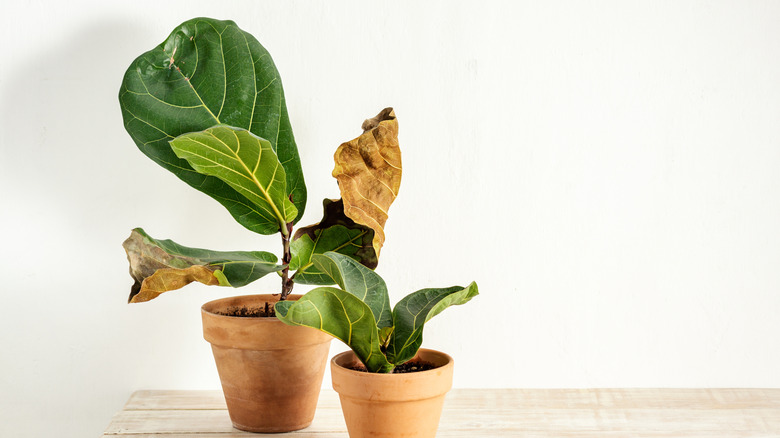The Simple Trick That Encourages New Growth For Fuller Plants
We may receive a commission on purchases made from links.
Pruning is a valuable skill if you love decorating with indoor plants. When you have a plant that's growing taller but not wider, it may need a nudge to produce more lateral branches. This is a great time to add notching to your pruning repertoire. Notching involves strategically slicing a stalk or trunk to convince the plant to form a new branch. The plant will send this new growth sideways rather than up, which creates a fuller look. In the houseplant world, notching is frequently used in growing rubber trees, fiddle leaf figs, and other houseplants with woody stalks. It's sometimes successful with Monstera plants as well. In the outdoor gardening realm, a similar technique is employed to increase fruit tree yields.
Notching encourages lateral branching by interrupting the movement of auxin, a hormone that trickles through a plant's main vertical trunk or stalk. Normally, auxin prevents the plant from branching out under its shoot apex, the uppermost region where new stems and leaves will sprout. By keeping lower branches from growing laterally, auxin helps the plant gain height. This is so it can access sunlight with ease. Auxin doesn't send its usual "reach for the sky" message when you notch its trunk in between nodes, which are the starting points for branches, buds, or leaves. As a result, the plant may send a lateral branch out of the wounded spot as it heals. After this happens, the plant's auxin resumes its usual role.
How to succeed at notching your houseplants
Locating your plant's nodes is your first order of business when notching. In houseplants, nodes often look like rings or places where one portion of a stem is growing over another. Sometimes nodes show up as little bumps near buds on the trunk. For notching, aim for nodes on tough, woody plant growth. Once you've found the necessary nodes, grab a cutting instrument that has been disinfected and sharpened. The X-ACTO Retract-A-Blade Utility Knife is a solid choice. Or, try a pruner like the Fiskars Garden Clippers.
Next, decide where you would like new branches to grow and mark the closest spots between two nodes. Also note which way the nodes are facing, which indicates the growth trajectories of the future branches. Make a clean, angled incision on each mark, slicing through 25% of the trunk. Every cut should cover ⅓ of the trunk's circumference. To achieve lush-looking growth, you may need several notches. A 2½ to 5 feet tall plant can typically handle six notches.
Don't panic if sap leaks from the plant as you're notching it. This often means that you've made a deep enough cut. Just clean up the mess with a damp rag so it doesn't bother your skin or attract houseplant pests. Also, resist the urge to remove leaves from the trunk at this point. This foliage helps the plant form buds that the new branches need to grow. Care for your plant as usual, providing its desired levels of water and sunshine, and it will sprout branches in a month or two if it's open to the idea.
Notching pitfalls to avoid
Notching won't always produce new branches, but it's still worthwhile to try when you want a bushier plant. In other words, set your expectations accordingly. Before you make any cuts, be sure you've chosen a type of plant that is likely to respond to notching — for example, a Ficus or Schefflera with a trunk-like stalk. Also, confirm when your plant's growth season takes place. This is when notching is most likely to bring about branching. If you attempt it at another time of year and don't see results, you may need to try it again in a few months, when your plant is primed for the process.
Since notching is a source of stress for plants, select a specimen that's healthy and fully developed. Shield your plant from other stressors to keep it from getting overwhelmed. For example, avoid repotting it and minimize temperature fluctuations while it's recovering from its cuts. If a houseplant is stressed out, it may show its displeasure by dropping leaves or refusing to grow new branches. Plus, stress makes it more vulnerable to pests and diseases. Jagged cuts also encourage disease-causing pathogens to attack your plant, so check that your cutting tool is nice and sharp but not serrated. Creating notches that are the right depth is especially important. If they're too shallow, the trunk will form a scar, but not a new branch. If they're too deep, your plant's trunk is at risk of snapping in two.


